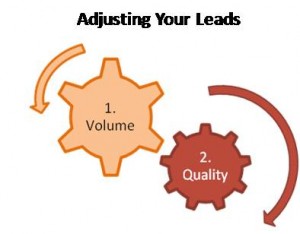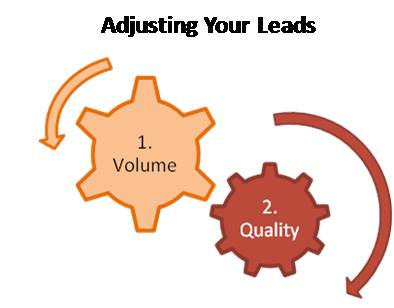If you’ve got a B2B website, you’re always looking for ways to generate more leads online. But while recent research shows 71% of B2B marketers view their site as one of the most important marketing tools, only 31% said their site is “highly effective” at generating leads.
That leaves a lot of room for testing and improving business results. However, optimizing for lead generation is not as straightforward as optimizing for conversion rate.
Conversion rate is the final metric that decides whether or not your online process/funnel is working. In contrast, lead generation only tells you a portion of the story. The leads you generate are really the start of a long process of qualification steps, both online and offline. If you don’t pay attention to each step, you will never be able to get the best out of this process.
How to use friction to your advantage
Think of the process of optimizing for lead generation as two interconnected dials. Each dial represents a step in your online process. One dial increases volume of leads by reducing friction. The second dial increases quality of the lead by increasing friction.
You can increase friction in several ways, such as adding more form fields or steps in the funnel process. Or, you can reduce it by subtracting various page elements or process steps. To adjust your lead flow, turn the dials: more friction will yield higher lead quality; less friction will increase lead volume.
Too much friction can make your visitors quit, but not enough friction will fill your pipeline with leads of a lower quality. So you need to test different approaches to determine what balance works best for your lead generation process.
Before you turn that dial …
Three keys to keep in mind when testing your lead generation process:
- Choose the right time to add more friction. Think of your lead generation process as a personal introduction to someone. The moment you meet someone you don’t ask for a lot of personal information. If you do, you scare people away. The same concept applies here. For example, in a recent experiment, we tested moving the phone number field from the first step to the second step. Lead generation rate increased by 68% and the conversion rate remained stable.
- Prioritize your requests properly. Think carefully about what information you ask first, second, and so on. It is important to keep a natural flow as you add and subtract friction elements. A good way to check for this with your pages and processes is to review every step and consider two questions: 1) Do we need this information? 2) Do we need it at this stage?
- Pay close attention to your final conversion rate. We tested a three-step process against a four-step process. As expected, the three-step process had a higher lead generation rate. However, once the sales team got the leads and started following up on them, they found that leads from the four-step process were more qualified and easier to close. Bottom line: the four-step process had a lower lead generation rate, but ultimately a higher final conversion rate (sales).
To learn more about applying this concept, see our recent research brief, What’s working now in optimization or join our team at our optimization workshop at MarketingSherpa’s B2B Summit.




This is something to keep under consideration at all times…helpful post thanks
Marketers do rely more on creativity than process. And though it is necessary for marketing teams to maintain strong creativity creative energy, they might be overlooking how clearly a defined process can benefit lead generation efforts. Lead generation is largely about repeatable processes that allow you to make continuous improvement. Similar to manufacturing, this is not just about automating the process, but also for improving it over time.
Gaby- I just discovered your post, I really like the dial approach that you use.
The last thing sales wants, or needs, is a large amount of leads that require too much time and work to be sales ready. This is just one example of how sales and marketing need to integrate their processes together. A mutual agreement of a qualified lead, what behaviors indicate that a sales touch is needed (and how sales approaches), is absolutely critical.
When both sales and marketing are operating under the same process and mindset that their ideal customer is- this becomes a habit. Closed loop analytics and testing helps the company become further aligned to their ideal customer, because they ‘get’ them.
Sales has the process, marketing uses creative to understand the mind of the buyer online. The buyer’s experience with the company has less surprises and disappointments.
Win-win-win.
Thanks for the post. The Marketing field can be a hard and tricky one but by changing the approach it can help the process become better.
I think when a website is well organized and targeted specifically with appropriate call to actions for the audience then it seems more compelling to entice its audience. Even though it varies from business to business. BTW, I found your idea very helpful. Thanks